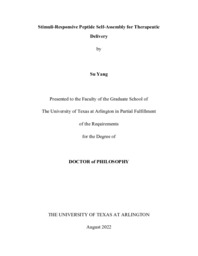
ATTENTION: The works hosted here are being migrated to a new repository that will consolidate resources, improve discoverability, and better show UTA's research impact on the global community. We will update authors as the migration progresses. Please see MavMatrix for more information.
Show simple item record
| dc.contributor.advisor | Dong, He | |
| dc.creator | Yang, Su | |
| dc.date.accessioned | 2022-09-15T14:11:22Z | |
| dc.date.available | 2022-09-15T14:11:22Z | |
| dc.date.created | 2022-08 | |
| dc.date.issued | 2022-08-16 | |
| dc.date.submitted | August 2022 | |
| dc.identifier.uri | http://hdl.handle.net/10106/30990 | |
| dc.description.abstract | Peptide self-assembly offers an effective method to generate supramolecular
nanomaterials with much higher stability than traditional monomeric peptides. The materials
exhibit well-organized hierarchical structures and high resistance toward proteolysis and have
been utilized extensively in various biomedical applications. Furthermore, due to the
prevalence of non-covalent interactions, these structures are highly dynamic. The dynamic
nature is beneficial for the design and synthesis of smart, trigger-responsive peptide selfassembly
under specific stimulus, in particular various stimuli associated with disease
conditions. In Chapter 1, I will introduce different types of peptide building blocks used for
the construction of peptide self-assembly. I will further discuss the design of triggerresponsive
peptide self-assembly that are formed under disease-specific triggers such as pH,
redox and enzymes.
In Chapter 2, I will focus on the design, synthesis, and characterization of a reductiveresponsive
self-assembled peptide nanofibers, to selectively target therapeutics to tumor cells
with high levels of glutathione. The peptide nanofibers exhibit supramolecular-structure
dependent cell penetrating activity and can be controlled with a reductive tumor
microenvironment. The reduction-dependent structure and activity were thoroughly
investigated using combined biophysical methods and in vitro cell-based assay.
In Chapter 3, I conducted a more systematic design approach to understand the
relationship between supramolecular structure and cell penetrating activity. A small library of
multidomain peptides (MDPs) with a general sequence of Kx(QW)6Ey was synthesized and
used to probe the supramolecular structure-dependent cell penetrating activity. It was found
that cell penetrating activity is dictated by both supramolecular stability and conformational
flexibility of the charged domain. Preliminary screening studies identified K10(QW)6E3 as the
self-assembling precursor to form nanofibers with most potent cell penetrating activity. This
sequence was further selected for the construction of enzyme-responsive cell penetrating
nanofibers for tumor cell targeting, which will be described in Chapter 4.
In Chapter 4, I will discuss my efforts on a more advanced design and synthesis of
peptide nanofibers with enzymatic-controlled cell penetrating activity. This work could open
new avenues for cancer imaging and therapy due to their potential of targeting overexpressed
enzymes in different cancer tissues. Specifically, we synthesized a new family of MDPs that
can undergo enzyme-mediated molecular transformation and supramolecular assembly to
form nanofibers. The MDP is designed to have three modules, a membrane-active selfassembling
(SA) module, a cationic capping (CC) module and labile linker (LL) module. The
hypothesis is in the presence of the cationic CC domain, due to the abundance of the cationic
charges and increased electrostatic repulsion, MDPs do not self-assemble and therefore have
weak membrane activity. When the external stimulus is applied under specific cellular
condition, the LL domain is cleaved to release the CC domain. Consequently, the ability of
MDPs to self-assemble is restored to form nanofibers with improved membrane activity. As a
proof-of-concept study, we chose matrix metalloproteinase 2, MMP-2 as our initial cellular
target due to its overexpression by cancer cells. We synthesized an MDP consisting of an
MMP-2 responsive substrate as the linker and observed high cell penetrating activity in the
presence of MMP-2. In vitro cell-based assay supports our design based on the therapeutic
efficacy against cancer cells with and without endogenous MMP-2.
In Chapter 5, I will shift gear and discuss our recent work for the development of pHresponsive
peptide materials which have potential for both anticancer and antimicrobial
therapy development. This approach is based on the self-assembly of peptides containing
unnatural ionic amino acids with an aliphatic tertiary amine side chain. These residues
generally have a high pKa value in the basic pH range and may be less useful for the design
of biomaterials. We found that when they are incorporated in a peptide self-assembly, the
hydrophobic microenvironment within the assembly shifts their pKa significantly from a
basic pH to a more biologically relevant pH in the weakly acidic range, therefore greatly
boosting their therapeutic potential. I will discuss in detail the synthesis, structural
characterization and antimicrobial activity of these pH-responsive peptide self-assembly. | |
| dc.format.mimetype | application/pdf | |
| dc.language.iso | en_US | |
| dc.subject | Peptide self-assembly | |
| dc.subject | Stimuli-responsive | |
| dc.title | Stimuli-Responsive Peptide Self-Assembly for Therapeutic Delivery | |
| dc.type | Thesis | |
| dc.degree.department | Chemistry and Biochemistry | |
| dc.degree.name | Doctor of Philosophy in Chemistry | |
| dc.date.updated | 2022-09-15T14:11:22Z | |
| thesis.degree.department | Chemistry and Biochemistry | |
| thesis.degree.grantor | The University of Texas at Arlington | |
| thesis.degree.level | Doctoral | |
| thesis.degree.name | Doctor of Philosophy in Chemistry | |
| dc.type.material | text | |
Files in this item
- Name:
- YANG-DISSERTATION-2022.pdf
- Size:
- 12.00Mb
- Format:
- PDF
This item appears in the following Collection(s)
Show simple item record


